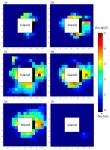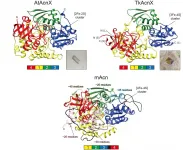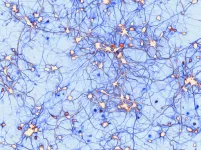Stroke treatment may backfire when kidneys don't work well
2021-07-08
(Press-News.org) Researchers at the National Cerebral and Cardiovascular Center in Japan show that excessive blood pressure reduction for acute intracerebral hemorrhage is risky in people with decreased kidney function
Suita, Japan -- Stroke and chronic kidney disease are both difficult to handle in their own rights, but having a stroke when your kidneys are already poor is more than just double the trouble. A new study led by Kazunori Toyoda at the National Cerebral and Cardiovascular Center (NCVC) in Japan shows that excessive blood pressure reduction for acute intracerebral hemorrhage can have dire consequences when kidney function is low. The study was published in the scientific journal Neurology®.
Intracerebral hemorrhage is a disease for which effective treatment is expected to be established. Abnormally high blood pressure is usually observed in the acute phase of intracerebral hemorrhage. Previous clinical studies have shown that intense blood pressure reduction in acute intracerebral hemorrhage patients can improve the clinical outcome. However, excessive blood pressure reduction can damage the kidneys, especially in people who already have chronic kidney disease. "Without a clear understanding of how kidney function affects the overall outcome when controlling blood pressure in these situations, doctors cannot make the best decisions for immediate stroke treatment," senior co-author Masatoshi Koga explains.
Kidney function is typically assessed using the estimated glomerular filtration rate (eGFR), which evaluates how well your kidneys are filtering out toxins from the blood. To determine if kidney function can affect the outcome after intracerebral hemorrhage, the researchers looked at data from an NIH-funded clinical trial, the Antihypertensive Treatment of Acute Cerebral Hemorrhage II (ATACH-2), led by Professor Adnan I. Qureshi, a co-author of this article. In ATACH-2, patients within 4.5 hours of onset of intracerebral hemorrhage were randomly assigned to the intensive antihypertensive group (systolic blood pressure 110-139 mmHg) or the standard antihypertensive group (140-179 mmHg) and maintained in the target blood pressure range for 24 hours. The primary endpoint of the study was the rate of death or severe functional disability at 3 months.
In the current study, researchers divided patients into three categories based on their eGFR at the time of admission, which correspond to normal function, mild loss of function, and decreased kidney function.
The researchers found that the rate of death or disability after stroke was almost 50% in patients with decreased kidney function, compared with about 32% in patients with normal kidney function. They next looked at what happened when patients were treated with an intensive blood pressure-lowering regimen. They found that compared with the standard treatment, the effect of this intense treatment changed depending on the eGFR levels at admission. Among patients with decreased kidney function, the odds of death or disability were higher in patients treated with intensive blood pressure-lowering compared with those with standard blood pressure control. In contrast, the treatment effect (intensive vs. standard) was similar among the other two groups.
First author Mayumi Fukuda-Doi thinks that these findings have important implications. "Although intense lowering of blood pressure can reduce the risk of hematoma expansion and prevent brain damage after stroke, we found that it can harm those with eGFR values less than 60, who have decreased kidney function," she says. "Detailed mechanisms of the effects of excessively lowering of blood pressure in acute intracerebral hemorrhage patients, as well as the appropriate target blood pressure for those with kidney dysfunction, need to be studied. At present, renal function should be considered when deciding the optimal blood pressure range for each patient."
INFORMATION:
The article, "Impact of renal impairment on intensive blood pressure-lowering therapy and outcomes in intracerebral hemorrhage: Results from ATACH-2," was published in the July 1, 2021 issue of Neurology®, the medical journal of the American Academy of Neurology at DOI: http:doi.org/10.1212/WNL.0000000000012442.
ELSE PRESS RELEASES FROM THIS DATE:
2021-07-08
Rare-earth compounds have fascinated researchers for decades due to the unique quantum properties they display, which have so far remained totally out of reach of everyday compounds. One of the most remarkable and exotic properties of those materials is the emergence of exotic superconducting states, and particularly the superconducting states required to build future topological quantum computers. While these specific rare-earth compounds, known as heavy fermion superconductors, have been known for decades, making usable quantum technologies out of them has remained a critically ...
2021-07-08
A new study suggests sea discoloration data obtained from satellite images as a novel criterion in predicting if eruption looms for an underwater volcano.
There have been frequent eruptions of submarine volcanoes in recent years. The past two years alone recorded the explosions of Anak Krakatau in Indonesia, White Island in New Zealand, and Nishinoshima Island in Japan. Observing signs of volcanic unrest is crucial in providing life-saving information and ensuring that air and maritime travel are safe in the area.
Although predicting when a volcano will erupt can be difficult as each behaves differently, scientists are on the lookout for these telltale signs: heightened seismic activity, expansion of magma pools, increases in volcanic gas release, ...
2021-07-08
A pioneering cultivation strategy that recreates a mangrove environment in the lab has enabled identification of novel bacteria residing in Red Sea mangroves and will help improve understanding of mangrove ecosystem stability, resilience and sustainability.
Mangroves are highly productive, dominant coastal ecosystems that line between 60-70 percent of the world's tropical and subtropical coastlines. They harbor diverse microbial communities thought to make up 80 percent of the ecosystem's biomass. Many of the microbial species, families and taxa are unknown to science.
The cultivation strategy was developed by a team of KAUST researchers, including Fatmah Sefrji and Ramona Marasco.
"Red Sea mangroves are particularly interesting because they represent an extreme and unique ...
2021-07-08
The aconitase superfamily currently contains four functional enzymes including the archetypical aconitase (referred to as "other aconitase enzymes"), and one hypothetical aconitase X (AcnX). The aconitase enzymes catalyze the homologous stereospecific isomerization, and their three-dimensional structures and catalytic mechanisms including the [4Fe-4S] iron-sulfur cluster are very similar each other (Fig. 1a). Therefore, the aconitase superfamily (enzymes) is a typical example that is suitable for the so-called "recruitment hypothesis of enzyme evolution"; the gene duplication of multi-specific enzymes, followed by the narrowing of substrate specificity (ref. 1).
AcnX (subfamily) is further classified into "AcnXType-I" consisting of a single ...
2021-07-08
Researchers at The University of Queensland, working to gain a better understanding of how brain cells work, have discovered the underlying mechanism of a rare genetic mutation that can cause epilepsy.
Dr Victor Anggono from UQ's Queensland Brain Institute said his team made the ground-breaking findings while researching nerve cell communications, which are an important process in normal brain function.
''We're both excited and astounded to make such an important contribution to the field of cellular and molecular neuroscience,'' Dr Anggono said.
He stressed that the mutation was extremely rare, with only one reported case in the world to date.
Dr Anggono's team studied protein structures, called receptors, that ...
2021-07-08
A study by researchers in the Scene understanding and artificial intelligence (SUNAI) research group, of the Universitat Oberta de Catalunya's (UOC) Faculty of Computer Science, Multimedia and Telecommunications, has developed a method that can learn to identify mosquitoes using a large number of images that volunteers took using mobile phones and uploaded to Mosquito Alert platform.
Citizen science to investigate and control disease-transmitting mosquitoes
As well as being annoying because of their bites, mosquitoes can be the carriers of pathogens. Rising temperatures worldwide are facilitating their spread. This is the case with the tiger ...
2021-07-08
While the UK was in lockdown, certain species of captive amphibians became more visible, a new study suggests.
The COVID-19 pandemic forced the closure of zoos across the UK for several months from March 2020, with gradual re-openings from summer into autumn and winter.
These closures provided a team of researchers, from the University of Exeter and WWT Slimbridge Wetland Centre, a unique opportunity to study the effect of visitor presence on several species of amphibian at Slimbridge.
The project assessed the number of individuals of six species - common toad, common frog, smooth newt, pool frog, golden mantella and golden poison dart frog - visible to observers while their exhibit was closed, when it partially reopened to more staff and when it reopened to visitors.
"Amphibians ...
2021-07-08
Lung cancer has the highest mortality rate of all cancers, and treatment options are extremely limited, especially for patients with oncogenic mutations in the KRAS gene. A great deal of hope was invested in the licensing of immune checkpoint inhibitors, but the reality is that some patients respond very well to this treatment while it is completely ineffective in others. In a paper just published in Science Translational Medicine, a MedUni Vienna research group led by Herwig Moll (Center for Physiology and Pharmacology) identified a potential marker for the success of immunotherapy in lung cancer patients and explained the underlying molecular processes.
K-Ras it is a monomeric G protein that plays a key role in the growth of malignant ...
2021-07-08
When you pour cream into a cup of coffee, the viscous liquid seems to lazily disperse throughout the cup. Take a mixing spoon or straw to the cup, though, and the cream and coffee seem to quickly and seamlessly combine into a lighter color and, at least for some, a more enjoyable beverage.
The science behind this relatively simple anecdote actually speaks to a larger truth about complex fluid dynamics and underpins many of the advancements made in transportation, power generation, and other technologies since the industrial era--the seemingly random chaotic motions known as turbulence play a vital role in chemical and industrial ...
2021-07-08
The ratios between the lengths of the second and fourth fingers, known as the 2D:4D ratio, are different in males and females, which is often explained by levels of androgens and oestrogens. However, an alternative theory states that men have bigger body parts, including fingers, which impacts the 2D:4D ratio. A research team including HSE University scholars refuted this hypothesis by collecting data on finger length from 7,500 people. The results of the study were published in Scientific Reports. https://www.nature.com/articles/s41598-021-87394-6
The ...
LAST 30 PRESS RELEASES:
[Press-News.org] Stroke treatment may backfire when kidneys don't work well






